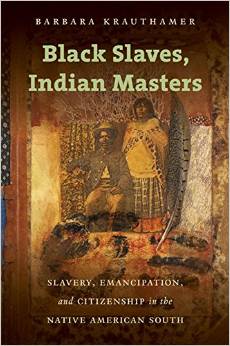Krauthamer, Barbara. Black Slaves, Indian Masters: Slavery, Emancipation, and Citizenship in the Native American South.. The University of North Carolina Press, 2013.
Reviewed by Ghada Kanafani Elturk
Boulder Public Library Multicultural Outreach Librarian
In Black Slaves, Indian Masters, Barbara Krauthamer examines the history of black slavery by the Choctaw and Chickasaw Nations in the American southeast territories from the late 18th century through the end of the USA Civil War. The territories are presented as another place of black exploitation, emancipation, and struggle for meaningful freedom and citizenship. The slaveholders were shrewd business people, whether they were Choctaw, Chickasaw, or white, who sought to maintain social and economic order. At the same time, Choctaw and Chickasaw slaveholders neither accepted Euro-Americans’ ideology of white superiority nor did they see their interests as identical to those of White southerners.
To better understand the complexity of race and slavery in the South, Krauthamer skillfully weaves the painful histories and journeys of the indigenous nations and enslaved blacks by looking at the intersecting dynamics of power and justice.
In the spring and summer of 1866, the Choctaw, Chickasaw, Cherokee, Creek, and Seminole Nations agreed to the final terms of their respective treaties with the USA government. The treaties did not present a unified course of action for the nations’ leaders or former enslaved, but they did map a new course for black citizenship. Following the Treaty of 1866, the United States government required the Choctaw and Chickasaw nations to abolish slavery within their territories and grant citizenship to the freedpeople.
Leaders of these nations contested freedpeople’s right of return, challenged the legitimacy of citizenship claims, and excluded freedpeople from annuity payments. They linked the issue of black citizenship to federal policies designed to undercut Indian landholdings and tribal sovereignty. In indigenous society, citizenship translated into terms of familial and tribal bonds, and members of the Choctaw and Chickasaw nations saw the treaty’s provisions as a threat to their identity: “the number of freedmen being so great, if adopted, will soon control our schools and government … we love our homes, institutions and government and will not surrender them” (140-14).
The contradiction between defending black people’s freedom and rights while undermining native people’s political and territorial autonomy was very clear to the Choctaw, Chickasaw, and black leaders alike. Lawmakers enacted a series of laws imposing racial segregation, which disfranchised black voters. The national government created patrols and required freedpeople to carry written passes; in addition, they created laws that punished with lashing any individual found without a pass. This punishment could be inflicted either by the light horsemen or any citizen of the nation, bringing to mind present issues with border patrols and “Stand Your Ground” laws.
Krauthamer’s book could serve as useful material for understanding complex racial histories and foster dialogues between communities of color, and I recommend this book for adult readers, tribal libraries and colleges.
Contents Note:
Race, Gender and Power — Christianity, Colonialism and Struggles Over Slavery — Slaves Resistance, Sectional Crisis and Political Factionalism in Antebellum Indian Territory — The Treaty of 1866 and the Emancipation and the Conflicts over Black People’s Citizenship Rights and Indian Nations’ Sovereignty — Freedmen’s Political Organizing and the Ongoing Struggles over Citizenship, Sovereignty and Squatters — Allotment, Race and Citizenship in the West.
About the Author
Barbara Krauthamer is associate professor of history at the University of Massachusetts-Amherst.
